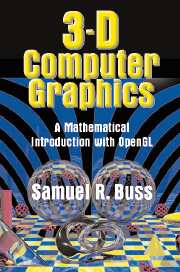Book contents
- Frontmatter
- Contents
- Preface
- I Introduction
- II Transformations and Viewing
- III Lighting, Illumination, and Shading
- IV Averaging and Interpolation
- V Texture Mapping
- VI Color
- VII Bézier Curves
- VIII B-Splines
- IX Ray Tracing
- X Intersection Testing
- XI Radiosity
- XII Animation and Kinematics
- A Mathematics Background
- B RayTrace Software Package
- Bibliography
- Index
- Plate section
XII - Animation and Kinematics
Published online by Cambridge University Press: 05 June 2012
- Frontmatter
- Contents
- Preface
- I Introduction
- II Transformations and Viewing
- III Lighting, Illumination, and Shading
- IV Averaging and Interpolation
- V Texture Mapping
- VI Color
- VII Bézier Curves
- VIII B-Splines
- IX Ray Tracing
- X Intersection Testing
- XI Radiosity
- XII Animation and Kinematics
- A Mathematics Background
- B RayTrace Software Package
- Bibliography
- Index
- Plate section
Summary
Overview
The term animation refers to the process of specifying or controlling the movement of objects. Of particular concern to us in this chapter is the use of mathematical techniques to aid in the programming of animation.
Traditional animation techniques, used notably in movies, substantially predate computerized animation. Traditionally, animation requires drawing a series of pictures, each picture showing an instantaneous snapshot of objects in motion. These are then displayed in rapid succession, giving the visual effect of smooth motion. The same general idea applies to computer animation: a software program repeatedly renders a three-dimensional scene with each scene showing the objects at a particular point in time. These scenes are then displayed at a sufficiently fast frame rate to give the visual illusion of motion.
Nowadays, much of the work of animation is being taken over by computers. An artist will create objects, people, creatures, and so on as three-dimensional models in a CAD program. These models can include information about the formation and permissible motions of the objects. For instance, an object may have a skeleton of rigid links connected by joints, and the joints can be given characteristics that control their motion. The rest of the object can be controlled to move in synchronization with the skeleton. One such technique is called skinning and permits the “skin,” or surface, of a creature to move in conjunction with the movement of the skeleton.
- Type
- Chapter
- Information
- 3D Computer GraphicsA Mathematical Introduction with OpenGL, pp. 289 - 318Publisher: Cambridge University PressPrint publication year: 2003



